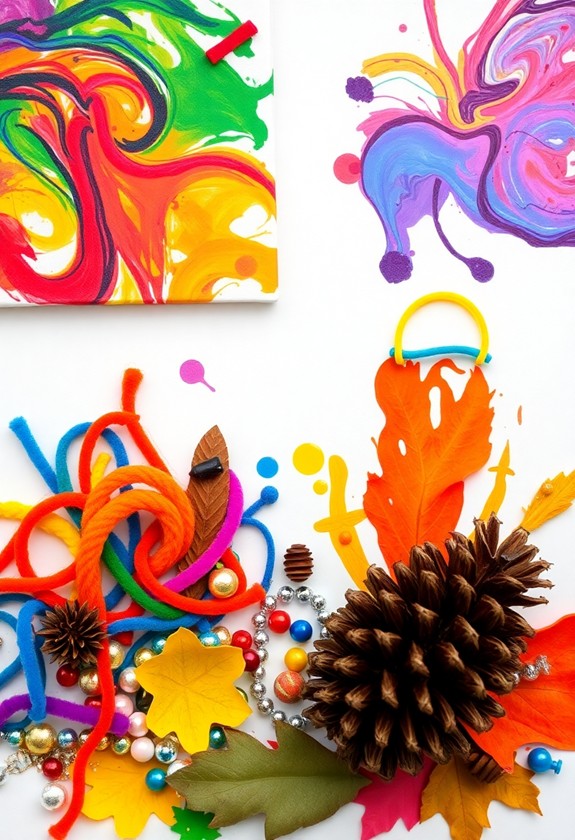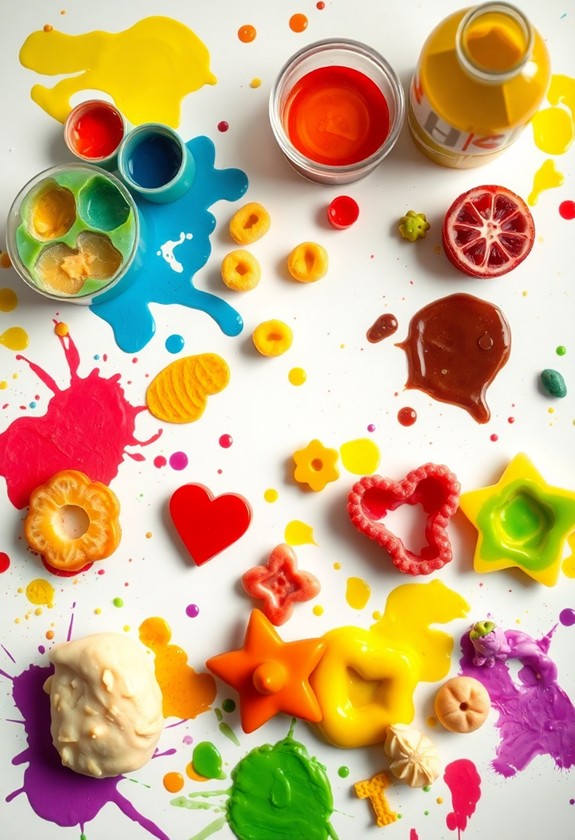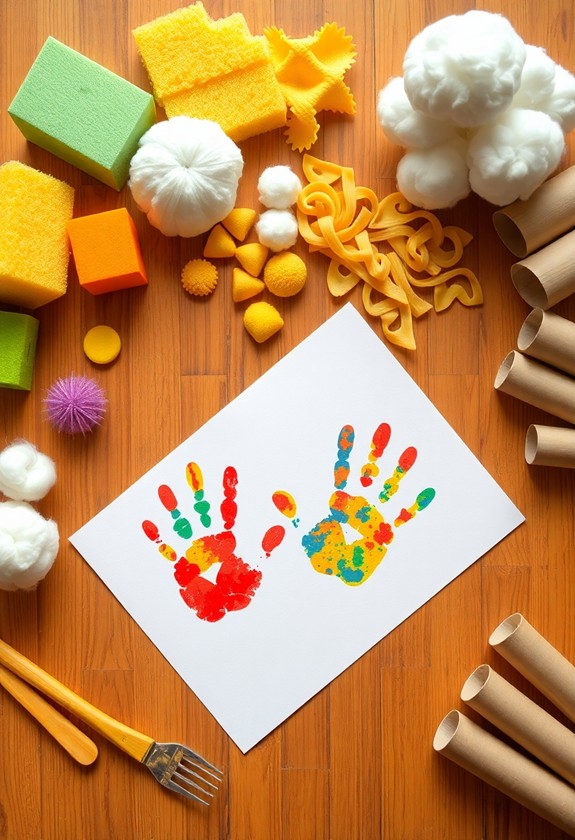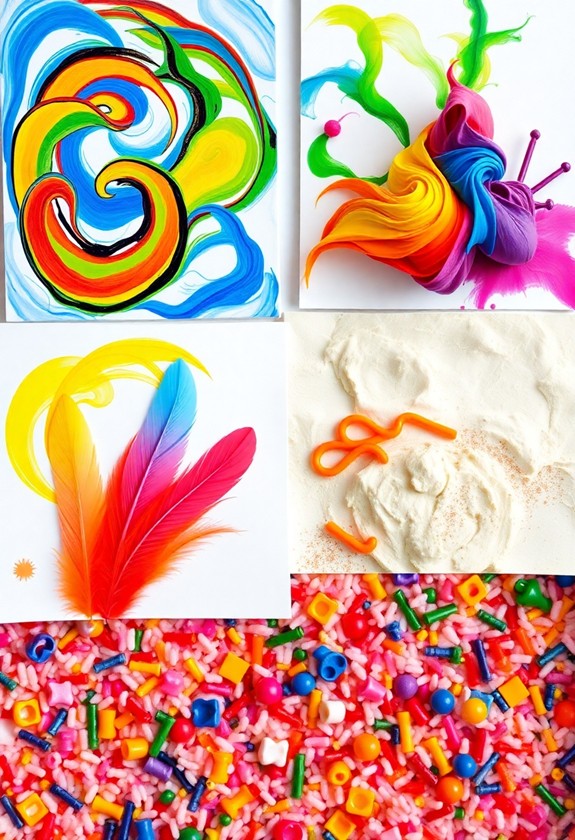Get ready for a sensory adventure with these five amazing art projects! You'll love squishing colorful paint, investigating textures in a collage, and molding scented playdough. How about finger painting with edible yogurt? Yum! And don't forget the mesmerizing sand art experience! These activities will spark your creativity, engage your senses, and develop fine motor skills. From squishy to smooth, rough to soft, and even tasty – your little hands will be busy researching a world of textures, colors, and scents. Who knew art could be so fun and multisensory? Immerse yourself and let your imagination run wild! There's so much more to uncover about each exciting project.
Creative Highlights
- Squishy Paint Exploration combines cornstarch and water for tactile finger painting, fostering fine motor skills and creative expression.
- Textured Collage Adventure uses diverse materials to enhance sensory processing and problem-solving abilities through crafting.
- Scented Playdough Creations incorporate natural fragrances into playdough, supporting cognitive development and imagination.
- Edible Finger Painting Fun uses yogurt and food coloring for a safe, tasty art experience that engages multiple senses.
- Sensory Sand Art Experience promotes visual and tactile stimulation through colorful sand layering and shaping activities.
Squishy Paint Exploration
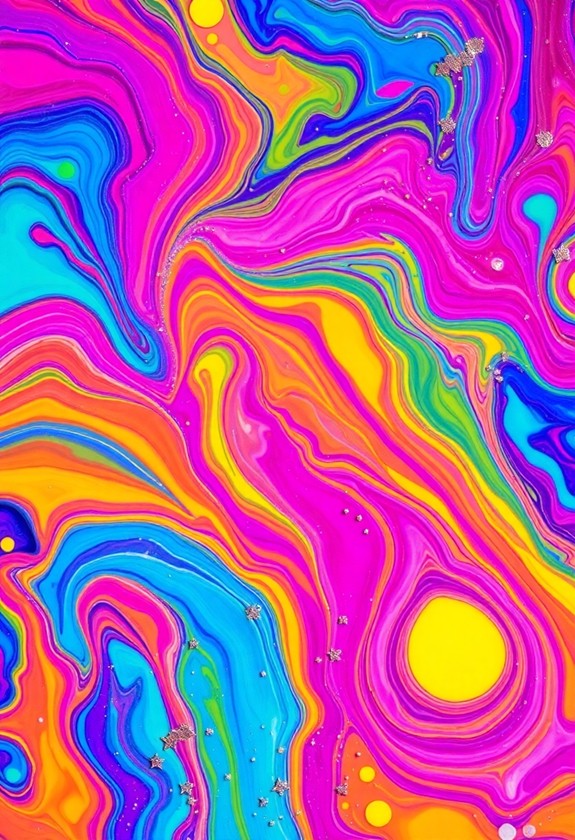
Bursting with lively colors and tactile sensations, squishy paint exploration offers children a delightful way to engage their senses as they create art. You'll love watching your little ones squish, squeeze, and smear their way to artistic masterpieces! This activity enhances fine motor skills and encourages creative expression, much like popular craft kits designed for toddlers. Here's how to get started:
- Mix equal parts cornstarch and water in a bowl
- Add food coloring or liquid watercolors
- Stir until you've got a gooey, squishy consistency
Now, let the fun begin! Spread the paint on a flat surface and encourage your kids to:
- Finger paint and make handprints
- Use brushes, sponges, or toys to create textures
- Squish it between their fingers for a sensory explosion!
This messy, marvelous activity is certain to paint smiles on their faces. It's a hands-on way to learn about colors, textures, and the joy of creating!
Textured Collage Adventure
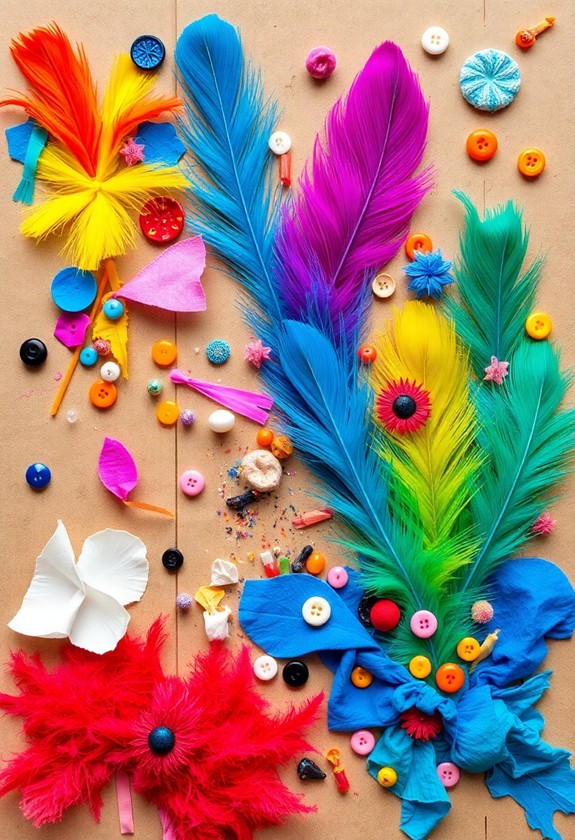
From squishy sensations to a world of textures, let's move on to creating textured collages. This adventure will have your little ones feeling their way through art! Gather an array of materials with different textures:
- Soft: Cotton balls, felt, feathers
- Rough: Sandpaper, burlap, twine
- Smooth: Foil, plastic wrap, ribbons
This multi-sensory experience aids in memory retention and information processing, essential for early childhood development. Regular crafting stimulates brain regions associated with problem-solving, creativity, and motor skills.
Now, let the fun begin! Spread out a large piece of paper or cardboard as your base. Encourage your kids to investigate the textures with their hands. How do they feel? Next, have them arrange and glue the materials onto the base. They can create patterns, shapes, or even a textured panorama!
But wait, there's more! Add some visual pizzazz with colorful paint splatters or glitter. The result? A tactile masterpiece that's a feast for the fingers and eyes!
Scented Playdough Creations
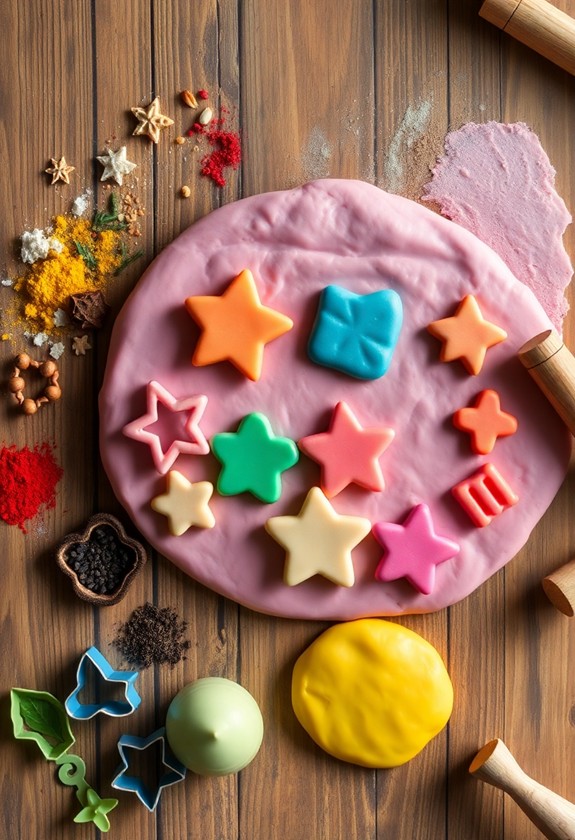
Let's plunge into the aromatic world of scented playdough creations! This fun activity will have your little ones sniffing and squishing with delight. You'll need a basic playdough recipe, but here's where the magic happens: add natural scents! Enhancing creativity and self-expression, this sensory-rich experience supports cognitive development through engaging, hands-on exploration.
Try these exciting options:
- Lavender for a calming effect
- Lemon for a zesty zing
- Cinnamon for a warm, spicy aroma
Mix in a few drops of vital oil or spices, and watch your child's eyes light up! They'll love kneading the dough, inhaling the scents, and creating all sorts of imaginative shapes. It's a sensory explosion that'll have them coming back for more!
But wait, there's more! Why not turn it into a guessing game? Have your kids close their eyes and try to identify the scents. It's nose-tastic fun!
Edible Finger Painting Fun
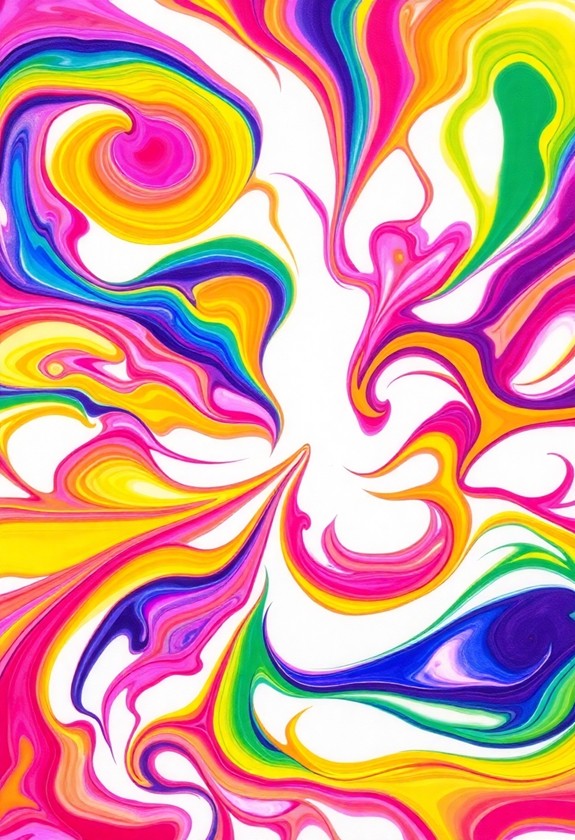
Now that we've examined the world of scents, it's time to engage another sense: taste! Get ready for some edible finger painting fun! This messy, delicious activity will have your little artists licking their fingers in delight.
Here's what you'll need:
- Plain yogurt
- Food coloring
- Large paper or plastic plates
Mix different colors of yogurt in separate bowls. Then, let the creativity flow! Encourage your kids to swirl, splatter, and smear their edible masterpieces. They can even add texture by using utensils or their fingertips to create patterns.
The best part? When they're done, they can lick their fingers clean! It's a taste-tastic way to investigate color mixing and sensory play. Just be prepared for giggles and sticky faces – this activity is certain to be a flavor-ite!
Sensory Sand Art Experience
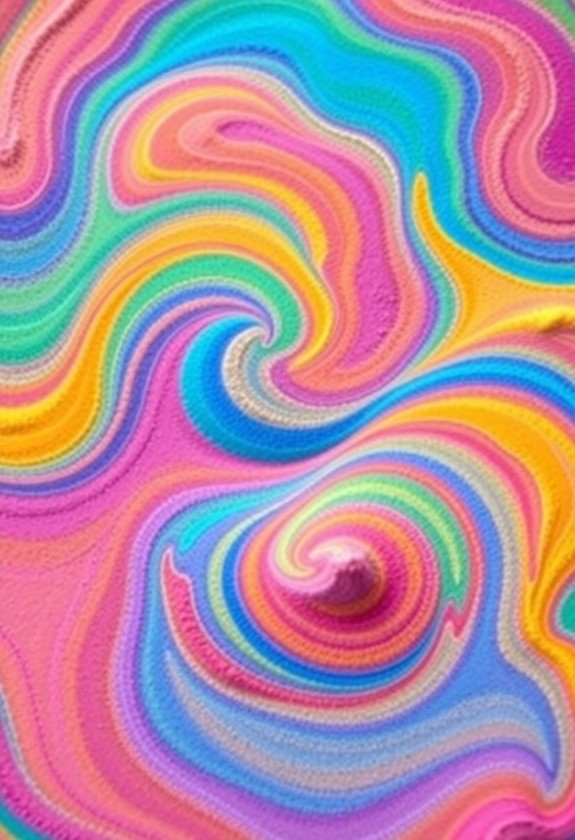
Occasionally, the simplest materials can create the most enchanting sensory experiences. Sand art is a fantastic way to engage your child's senses and spark their creativity! You'll need colored sand, clear containers, and some small tools like spoons or funnels. Let your little one's imagination run wild as they layer lively sands to create stunning patterns and designs!
Here's why sand art is so amazing:
- It's a tactile delight! Feeling the sand's texture is soothing and fun.
- It's visually stimulating, with endless color combinations to investigate.
- It encourages focus and fine motor skills development.
As your child pours and shapes the sand, they're not just making art – they're experiencing a whole new world of sensations! Watch their eyes light up as they uncover the joy of blending colors and creating unique, sandy masterpieces. It's time to get your hands sandy and immerse yourself in this sensory adventure!
Curious Little Questions
How Can I Adapt These Projects for Children With Sensory Sensitivities?
You've got this! Adapting projects for sensory-sensitive kids is a breeze. Here's how:
- Use gentler materials: Swap rough textures for smooth ones
- Offer noise-canceling headphones for loud activities
- Provide a quiet, calm space for breaks
- Let kids choose their comfort level
- Break tasks into smaller, manageable steps
- Use visual schedules to reduce anxiety
What Age Range Are These Sensory Art Projects Most Suitable For?
You'll love these projects for kids aged 3 to 8! They're perfect for little hands and big imaginations. Toddlers can enjoy simple sensory play, whereas older kids plunge into more complex creations. But don't worry, there's something for everyone! Even 2-year-olds can join in with supervision. And guess what? Older kids and adults might find these activities fun too! It's all about investigating textures, colors, and creativity. So, get ready for some sensory-sational fun!
Are There Any Potential Allergens to Be Aware of in These Activities?
You bet there are allergens to watch out for! In regard to sensory art, safety's key. Be mindful of common culprits like:
- Gluten in play dough
- Nuts in natural materials
- Dairy in some paints
- Latex in balloons or gloves
But don't worry! There are tons of allergen-free alternatives. Just swap out ingredients or materials as needed. Always check labels, and when in doubt, ask parents about specific allergies. With a little care, you'll create amazing, safe art experiences for all curious hands!
How Can I Incorporate Learning Objectives Into These Sensory Art Experiences?
You can easily weave learning objectives into sensory art experiences! Try these fun ideas:
- Count and sort materials by color or texture
- Investigate shapes and patterns as you create
- Practice letter formation with textured materials
- Discuss scientific concepts like mixing colors or states of matter
- Encourage storytelling about their creations
Every squish, splash, and smear becomes a chance to learn! You'll be amazed at how much they absorb during their fun. It's like sneaking veggies into their favorite snack – they won't even realize they're learning!
What Cleanup Tips Do You Recommend for Messy Sensory Art Projects?
Ready to tackle those messy art projects? Here are some awesome cleanup tips:
- Lay down old newspapers or a plastic tablecloth before you start. It's like magic – just roll it up and toss when you're done!
- Keep wet wipes handy for quick clean-ups. They're your artsy sidekick!
- Wear old clothes or smocks. You'll be a paint-covered superhero!
- Use washable paints and markers. They're easy-peasy to clean off surfaces.
- Have a bucket of soapy water nearby. It's your cleanup secret weapon!

